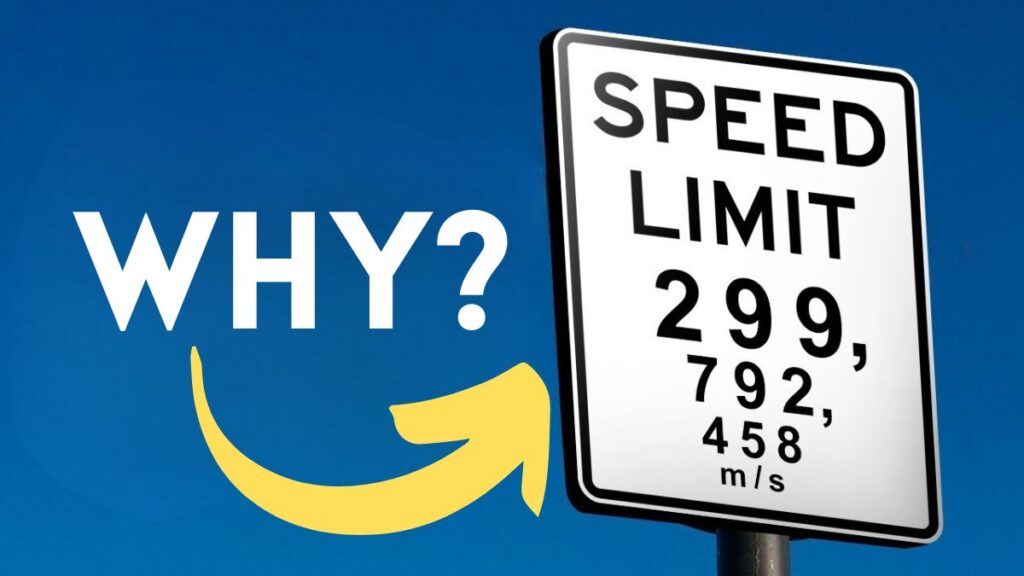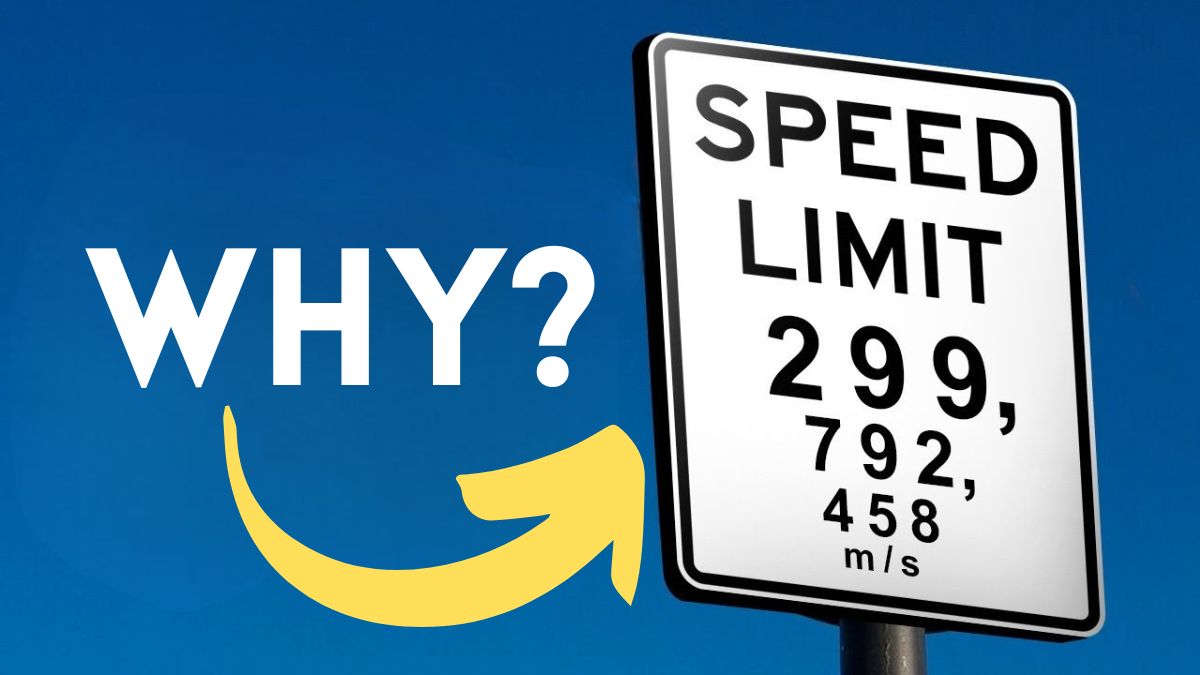
Why does reality have a speed limit?
It is common knowledge that the speed of light is the fastest that anyone can go, but why does this cap on causality exist?
And why is it exactly 299,792,458 m/s?
Why not more? Why not less?
If you’re like me, you’ve wondered about these strange properties of light, but recently I think I might have found an answer.
And it lies in hyperbolic geometry.
And the more I’ve considered it, the more it’s blown my mind.
Join with me today for the third part in our series on the unseen world, and bring together what we have learned so far to try to answer some of the biggest questions about why our universe is the way it is.
Before we begin, I should mention that this is a continuation of a model that has been developed in collaboration between me and my brother, which we began in this video about 4d space, and continued exploring in this video about the shape of our universe.
If you haven’t watched those videos yet, I would highly recommend you check them out, as we will be blending both concepts together in this video.
Here are the links if you need a refresher.
With that out the way, let’s talk a little bit about light.
There is an interesting observation we can make about light.
From an external perspective, it appears as if light is traveling at 299,792,458 m/s.
This is true no matter what perspective you look at it from; whether you are at standstill, whether you are moving towards it, or away from it.
It always looks as if it is traveling at 299,792,458 m/s.
However, there is a single, interesting exception to this rule which has always puzzled me.
The photon’s perspective.
Einstein has proven that for an object traveling at light speed, time would slow down so much that it would be at 0.
If you were to suddenly start traveling at the speed of light towards Jupiter, you would notice 0 time passing, but would observe that you have traveled 679 million km.
And then would promptly die of the lack of air, the punishing g-forces, and the friction burn along the way.
But what happens if we try to calculate your speed using these figures?
Well, s=d/t.
So, 679 million/0=… if you tried plugging this into your calculator, you would quickly run into an error here.
Calculators do not like dividing by zero.
This is because, the smaller the denominator becomes on a fraction, the larger the total number becomes.
If you reduce the value of the denominator all the way down to zero, the only way this can work is if your total answer becomes infinity.
If you travel for 0 time over any distance greater than zero, you have just traveled at infinite speed.
So from light’s perspective, it is traveling infinitely fast, not at 299,792,458 m/s (let’s call it “c”).
So why is it that everyone else detects light traveling at “c”, but light thinks it is going infinitely fast?
What I am about to share is one possible theory.
It’s going to involve a 4d hyperbolic space.
That’s quite a mouthful, so let’s take our time exploring this space, so we know what we’re talking about.
To quickly recap on the rules of a 4d space; let’s imagine that all of 3d reality has been compressed into a single flat line traveling horizontally across space.
This leaves us free to make everything up or down in this space into the future or the past.
To put it another way, the x axis represents moving through space, and the y axis represents moving through time.
This is how we get the extra dimension, our 4th d.
Here in 4d space, time is simply another direction we can go in.
Hyperbolic might sound a little intimidating too, but simply put, all it means is that all the lines diverge away from one another, always.
This has the effect of warping space in a way our brains don’t really process well, but essentially means there’s more and more space the further out you go.
But, exponentially so.
Other than that, traveling through this space obeys the same rules that traveling through 3d space uses, in terms of the physics rules involved.
Objects that start moving must be acted upon by another force or they will continue moving at the same rate.
Objects at rest remain at rest.
Conservation of momentum is maintained.
Now let’s imagine that for whatever reason, there was some big expansion event in the past that sent us all moving in the upwards direction.
A big bang, if you will.
I wonder where one of those might have come from?
But this expansion was not simply in space, but in time too – it’s a 4d explosion.
We are now in motion, moving solely up, at the top of this expanding bubble – for now, we are not moving anywhere in space, we are simply moving forwards in time.
We travel consistently, and will continue to travel consistently until we are acted upon by another object or force.
But as we are new and there is nothing but empty space above us, we are going to go up infinitely – there’s nothing up there to bump into.
Now, let’s imagine for a second that we decide we no longer want to go straight up.
Let’s try to change direction.
In physics, any change of direction is a form of acceleration.
This may not make much sense intuitively, but it becomes easier to understand if we split our vector into two components: our velocity in the x-direction and our velocity in the y-direction.
It then becomes easy to see that changing our direction comes about by decelerating with one of our values and accelerating with the other.
We don’t have to change both values, though.
Let’s just give ourselves a little impetus in the x-direction.
Obviously, the more we are pushed, the faster we are going to travel, and the more our total vector begins to lean towards a perfect horizontal line.
The size of our vector increases.
However, let’s say that we want to go faster.
In fact, we want to go so fast that we are no longer traveling in the y direction, and are only moving in the x-direction, or “space”.
Is there any amount of push we can get in the x-direction that will make it so that we are actually going completely horizontally?
No, you could increase the distance in x by a larger and larger amount, but as long as y has some value, you will never actually get that vector perfectly going across space.
The only way you could get your vector in the “time” direction to slow down is if you pushed against something that’s ahead of you, or pulled on something behind you.
But if everything near you is in the same second you are in; there’s nothing to push against.
You can only push each other left or right.
Nothing is ahead or behind.
Interestingly, with only this available to you, your vector can trend closer and closer to flat, but it never actually reaches it.
And increasing your speed produces diminishing returns on how much flatter you can get your vector.
You have hit a limit.
You would essentially need to go infinite speed to approximate a flat line – and to go infinite speed, you would need infinite energy.
Difficult to get your hands on.
Of course, that is where this idea diverges from reality.
There’s nothing here so far that imposes a speed limit on our model.
You should easily be able to go faster than the usual 299,792,458 m/s speed limit.
With infinite energy, you could go 3 billion m/s, or 3 trillion.
But in the real universe, we don’t see that.
Everything normally seems to be capped at 299,792,458 m/s.
There is a similar trend where the more energy you put in, the less additional speed you get, but that occurs at close-to-light-speed, not infinite speed.
So, our 4d model seems to have failed.
But this is not a regular 4d space.
This is a hyperbolic 4d space.
Let’s observe what happens when you try to travel at near infinite speeds when the lines start to bend: here, you have zoomed along at a speed that’s as fast as infinite as you can manage.
“Speed” is a little tricky a concept here, but let’s say that from your perspective, you covered a distance of 400,000,000m in a second.
So, faster than the speed of light.
What happens?
Well, you hit this little curved line over here.
Although it is bent to be almost a “c” shape, if you follow the line down you will see that it is a timeline, not a space line.
And because it is a hyperbolic space, there is more here than meets the eye.
Let’s jump over to that point, and see where we ended up.
Although in our movement vector by our origin we only traveled one square high: by our end destination, we have ended up at a point multiple squares high: by taking a journey sideways, and by only experiencing a second of forward momentum through time ourselves, we have ended up many seconds into the future.
We have taken a shortcut into the future.
This is what we observe in the real world – objects that move at great speeds seem to suddenly experience reduced time.
They believe only a few seconds have passed, but far more time can occur to an external observer.
And suddenly it really throws off our math.
Because how does an external observer record our speed?
If we started at an origin point of 0, but ended at an origin point that’s seconds in the future, they have to say that we traveled 400,000,000m in 10 seconds, for a speed of 40,000,000m/s.
Far below the speed of light, no matter what we thought we were doing.
Which is kind of like what light seems to be experiencing.
And the faster you push yourself in the x direction, the more you encounter the warping effects of hyperbolic geometry, and the more it keeps pulling you back towards the speed limit cap of the universe.
It will never let you exceed it.
This explains why there is a speed cap to the universe.
Not even light, which as far as it is concerned does travel infinitely quickly, would be able to overcome it – provided the base we were resting on was ever so slightly curved: as soon as the photon slid above the plane that was space, it would get swept up in the curvature of this hyperbolic 4d space.
It would trace the limit of it, true, but it would get caught in it.
And then, from our perspective, it would start to look as if it were simply moving uniformly at a speed of 299,792,458 m/s.
After all, we would see it leave, and then we would time how long it would take to arrive at its destination.
It doesn’t matter for us that it believed it had arrived there instantaneously by taking a shortcut through time.
We would just record it as having arrived after some time had passed.
So, there you have it.
Why is there a speed limit for our universe?
Perhaps because space is curved, and our 4d space is hyperbolic.
At least, so claims this theory.
It is, it must be stressed, just a theory.
It’s possible that smarter people than me in the comments will explain to me why this is wrong.
However, it does neatly explain to me why time dilation happens, and why reality has a speed limit, which I find quite appealing.
In fairness, perhaps the only way to test it would be to try to go faster than the speed of light, and we have never even gotten close to this speed.
The fastest a human has ever gone is 11,083 m/s, when nasa astronauts returned in a spaceship from the moon.
It would require incredible amounts of energy to travel 299,792,458 m/s, from our perspective.
If it is true, though, it would provide firm evidence that our universe really was hyperbolic in nature, and sadly, quash any hope for us traveling backwards in time at any point.
So; sorry, time travel fans.
But at least we can console ourselves that although we probably can’t travel to the past, traveling through shortcuts to the future is definitely within the realms of possibility.
The universe around me has always fascinated me.
What You think about this? Don’t Forget to Share your Thoughts !
Explore:





![Moon Jellyfish has [ Hidden Secrets ] You don't know moon jellyfish](https://spaceupper.com/wp-content/uploads/2022/11/1-1-300x169.jpg)

